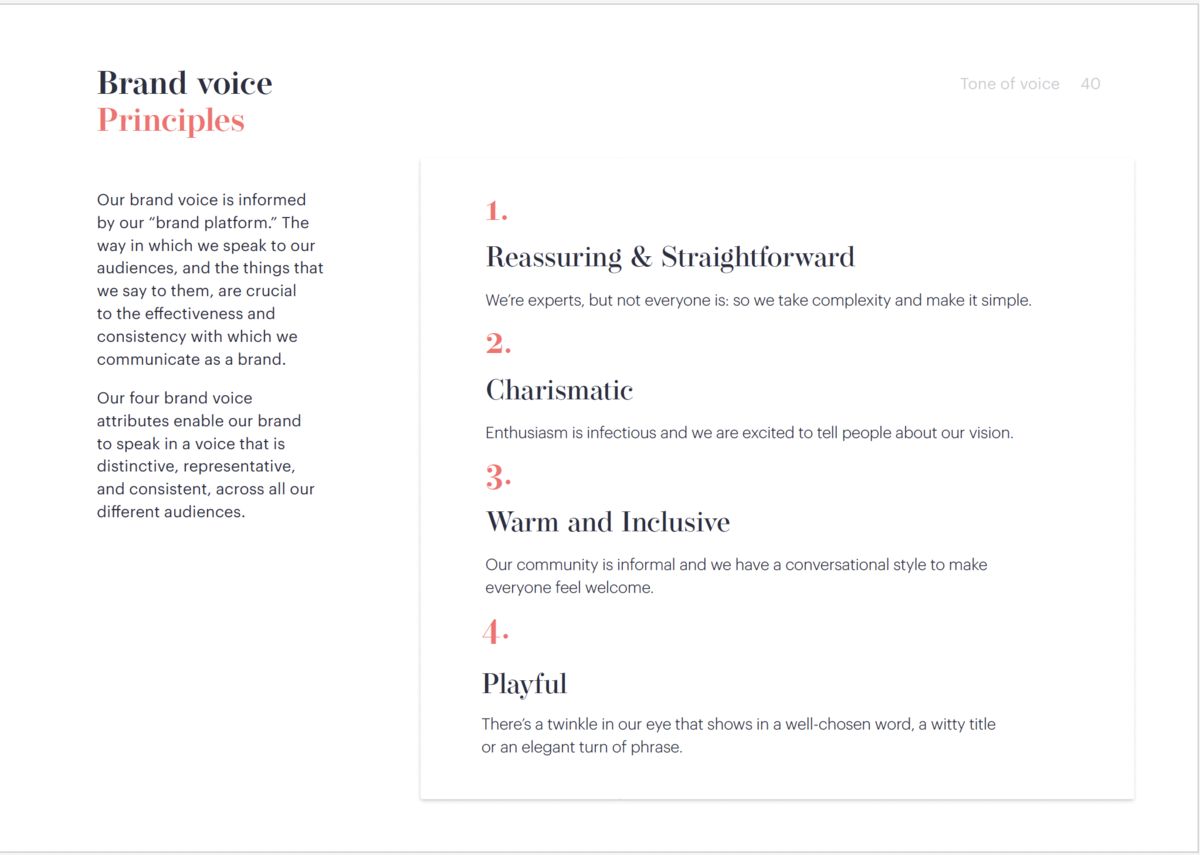It's pretty obvious that consistency is key to building a strong, trusted brand. We have never seen a client who wants choppy visuals across their website, emails, print materials and social media.
Why?
It hurts business – especially marketing and sales efforts – when the 'illusion' of a brand is broken. People quickly lose trust in things that are inconsistent. They have a radar for it.
By applying a unifying style (colors, words, imagery) across every area of a business, its easier to speak with a common voice and put the target audience at the heart of everything. And that drives growth.
This is hard for businesses though. Not all employees are designers and copywriters at heart. When different teams design emails, websites, packaging, marketing materials (etc) inconsistencies naturally appear.
This is where brand guidelines – often put into larger "brandbooks" – come into play.
Brand guidelines ensure that your brand is represented consistently everywhere (eg websites, social media, packaging, advertising, newsletters).
If you have a brand you're thinking about creating some brand guidelines, get in touch for a free conversation or audit.
What are Brand Guidelines and Brand Books?
Brand guidelines, also known as a brand style guide, are a set of rules and standards that define how your brand should be presented visually and verbally. This includes everything from how your logo is used and color palette, to your typography and tone of voice.
A brand book is a more comprehensive document that goes beyond the visual elements of your brand. It delves into your brand's story, mission, values, and personality, providing a deeper understanding of what your brand stands for and how it should be communicated.

Why are Brand Guidelines and Brand Books Useful?
Having a set of brand guidelines and a brand book offers numerous benefits for your business:
- Consistency: By clearly defining how your brand should be presented, you ensure that all of your marketing materials, designs, communications and sales efforts are consistent, regardless of who creates them.
- Recognition: Consistent branding helps your target audience easily recognize and remember your brand, building trust and loyalty over time.
- Efficiency: With a clear set of guidelines in place, your team and any external partners can create on-brand materials more efficiently, saving time and resources.
- Differentiation: Franky – a well-defined brand helps you stand out from your competitors. This is related to what we call brand philosophy or brand identity and forms a large part of what we do at Self.

Creating Your Own Brand Guidelines and Brand Book
Developing comprehensive brand guidelines and a brand book requires an understanding of your brand's identity, target audience, and goals. It's a process that involves research, strategic thinking, and creative execution.
Usually when creating a brand book – or even just brand guidelines – we are looking at:
- Tone of voice – how does the brand 'sound'? Friendly and modern? Professional and authoritative? Bold? Bigger (or smaller) than it is? Funny or serious?
- Target audiences – also known as personas. Say you're a hotel – are your clients established professionals on work trips or hip Gen-Zs?
- Logos – how to use them, what is not an acceptable edit or proportion etc
- Colors - an agreed set of primary and supporting colors
- Photography
- Tagline(s) – your brand in a single formula. The long version, and abridged, and a two-word version.
- Mission & values – the brand’s raison d’être and philosophy. A set of principles to guide brand purpose, personality, and proposition
- Target audience - eg conscientious, active, seeking out 'smart' solutions rather than the first one
- Examples – be sure to show 'how its meant to be done' for the people who will look at it (eg an email copywriter, a videographer on social etc).
While you can create these documents in-house, working with experienced branding professionals can help ensure that your guidelines are thorough, effective, and aligned with your overall business strategyC.
Can You Show Me A Brand's Guidelines or Template?
Send an email over to [email protected] and we'll send you a full PDF with examples you can adapt.
Or if you have a brand you're thinking about creating some brand guidelines, get in touch for a free conversation or audit.

Get A Custom Brand Book and Guidelines
Getting a brandbook or guidelines formalised isn't for everyone. If you're a small business, it's worth investing your time in sales and doubling down on channels that are working.
But if you're ready to take your branding to the next level, consider working with a team of branding experts. If you have a brand you're thinking about creating some brand guidelines, get in touch for a free conversation or audit. At Self we'll collaborate with you to develop a comprehensive brand book that captures your brand's essence and sets you up for long-term success. Set up a call with us here.
Brand Guidelines Examples
We've built guidelines for brands which were then used in stunning ad campaigns, mock-ups and interfaces and sales emails. Here's a few highlights:

Healthy vegan food brand Holy

Travel & adventure app Teleporting

Wellness platform inKin

Barbershop chain 'Chop Chop'

NFT Community Vastega
If you have a brand you're thinking about creating some brand guidelines, get in touch for a free conversation or audit.


